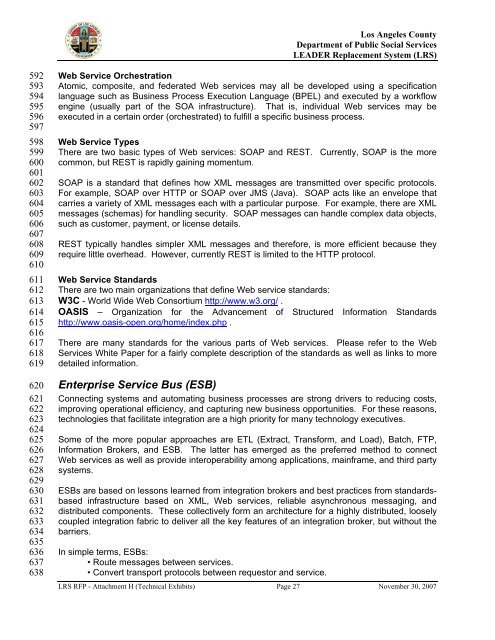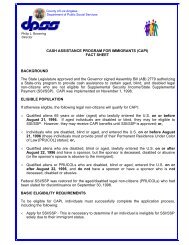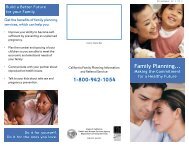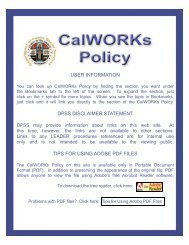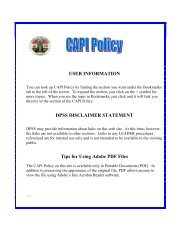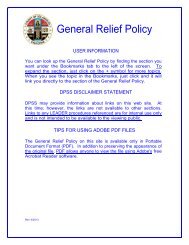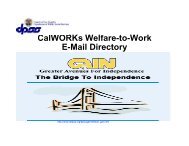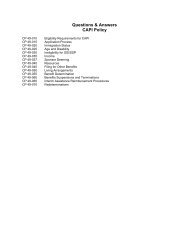leader replacement system - Department of Public Social Services ...
leader replacement system - Department of Public Social Services ...
leader replacement system - Department of Public Social Services ...
Create successful ePaper yourself
Turn your PDF publications into a flip-book with our unique Google optimized e-Paper software.
Los Angeles County<br />
<strong>Department</strong> <strong>of</strong> <strong>Public</strong> <strong>Social</strong> <strong>Services</strong><br />
LEADER Replacement System (LRS)<br />
592<br />
593<br />
594<br />
595<br />
596<br />
597<br />
598<br />
599<br />
600<br />
601<br />
602<br />
603<br />
604<br />
605<br />
606<br />
607<br />
608<br />
609<br />
610<br />
611<br />
612<br />
613<br />
614<br />
615<br />
616<br />
617<br />
618<br />
619<br />
620<br />
621<br />
622<br />
623<br />
624<br />
625<br />
626<br />
627<br />
628<br />
629<br />
630<br />
631<br />
632<br />
633<br />
634<br />
635<br />
636<br />
637<br />
638<br />
Web Service Orchestration<br />
Atomic, composite, and federated Web services may all be developed using a specification<br />
language such as Business Process Execution Language (BPEL) and executed by a workflow<br />
engine (usually part <strong>of</strong> the SOA infrastructure). That is, individual Web services may be<br />
executed in a certain order (orchestrated) to fulfill a specific business process.<br />
Web Service Types<br />
There are two basic types <strong>of</strong> Web services: SOAP and REST. Currently, SOAP is the more<br />
common, but REST is rapidly gaining momentum.<br />
SOAP is a standard that defines how XML messages are transmitted over specific protocols.<br />
For example, SOAP over HTTP or SOAP over JMS (Java). SOAP acts like an envelope that<br />
carries a variety <strong>of</strong> XML messages each with a particular purpose. For example, there are XML<br />
messages (schemas) for handling security. SOAP messages can handle complex data objects,<br />
such as customer, payment, or license details.<br />
REST typically handles simpler XML messages and therefore, is more efficient because they<br />
require little overhead. However, currently REST is limited to the HTTP protocol.<br />
Web Service Standards<br />
There are two main organizations that define Web service standards:<br />
W3C - World Wide Web Consortium http://www.w3.org/ .<br />
OASIS – Organization for the Advancement <strong>of</strong> Structured Information Standards<br />
http://www.oasis-open.org/home/index.php .<br />
There are many standards for the various parts <strong>of</strong> Web services. Please refer to the Web<br />
<strong>Services</strong> White Paper for a fairly complete description <strong>of</strong> the standards as well as links to more<br />
detailed information.<br />
Enterprise Service Bus (ESB)<br />
Connecting <strong>system</strong>s and automating business processes are strong drivers to reducing costs,<br />
improving operational efficiency, and capturing new business opportunities. For these reasons,<br />
technologies that facilitate integration are a high priority for many technology executives.<br />
Some <strong>of</strong> the more popular approaches are ETL (Extract, Transform, and Load), Batch, FTP,<br />
Information Brokers, and ESB. The latter has emerged as the preferred method to connect<br />
Web services as well as provide interoperability among applications, mainframe, and third party<br />
<strong>system</strong>s.<br />
ESBs are based on lessons learned from integration brokers and best practices from standardsbased<br />
infrastructure based on XML, Web services, reliable asynchronous messaging, and<br />
distributed components. These collectively form an architecture for a highly distributed, loosely<br />
coupled integration fabric to deliver all the key features <strong>of</strong> an integration broker, but without the<br />
barriers.<br />
In simple terms, ESBs:<br />
• Route messages between services.<br />
• Convert transport protocols between requestor and service.<br />
LRS RFP - Attachment H (Technical Exhibits) Page 27 November 30, 2007


